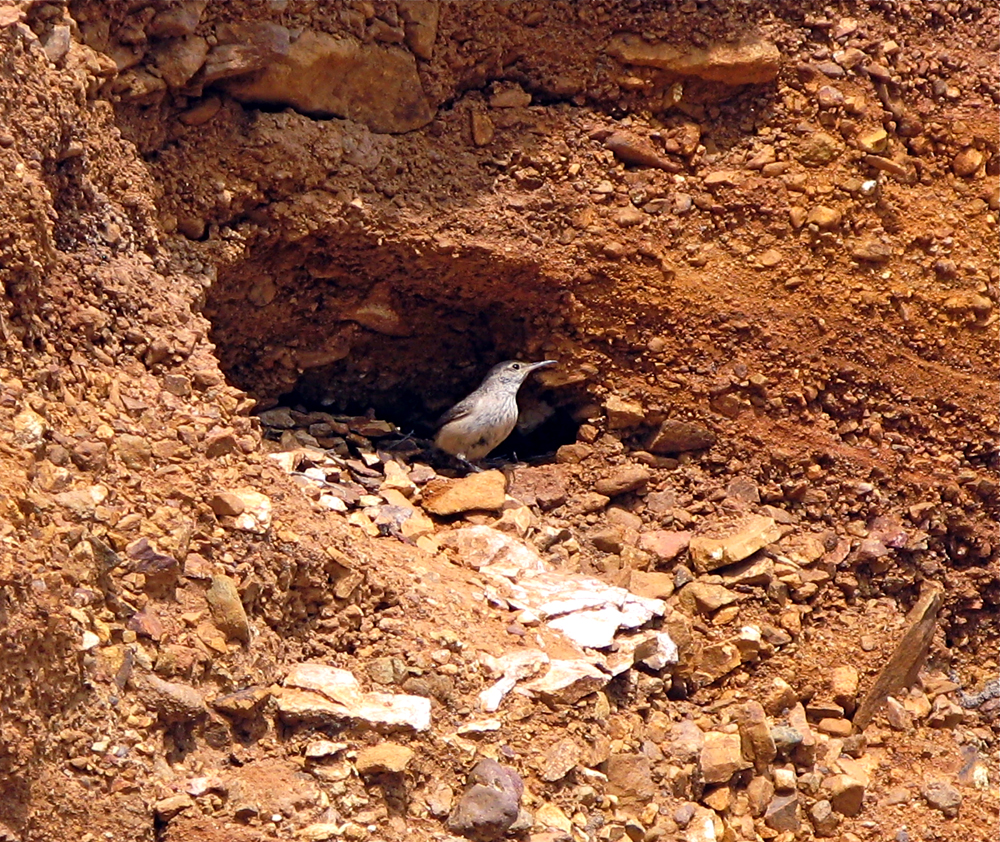Wren rocks
When you get out, you see things.
On a recent drive through a favorite stretch of desert mountain backroad, we saw a small thing that I’ve always wanted to see, ever since reading about it. We saw it. And I got a picture of it. It’s this:
A tiny bird in a tiny hole in a big desert-dirt wall above a desert dirt road. (Photo A.Shock)
That’s a Rock Wren — Salpinctes obsoletus — standing at the entrance to its nest cavity. It’s not the bird itself that I’ve been hankering to see, because I’ve seen a few Rock Wrens: in the right place and time, they’re largely (or small-ly) unavoidable in craggy arid regions of the western US, Mexico, and Canada. We even have them in our neighborhood occasionally. What I was so excited about is the small expanse of rock chips to the left of the bird: the Rock Wren’s very rocks!
It’s not actually a pile, please, it took more effort than that. It’s a pavement. A mysterious pavement. Rock Wrens are known to construct paved areas leading to their nests, and sometimes to lay a foundation of flat stones under the cup nest they construct in a crack, crevice, hollow, split boulder, or other rocky vug. But no one knows why, exactly.
Building this pavement requires a lot of time, energy, and effort. Each bird of a nesting pair carries stone after stone in its beak from its source to the nest — sometimes as many as two or three hundred, then deliberately sets them in front of its chosen inaccessible and hidden location. Both males and females have been seen doing this, although some observers report that it’s mostly the females who pave. The stones are flat, and though they’re small by our human scale, they can weigh up to a third of the bird’s body weight. Theories about why they go to the trouble lie as thick on the ground as wren-rocks, ranging from pair-bonding to mate-evaluating activities, to nest and nestling thermoregulation, to steep site soil stabilization, to landing pad or sign-post or defensive barrier. Ornithologists studying an unrelated old-world species, the Blackstart, hypothesized that stone pavements or ramparts built by their subject birds could function as a predator defense system, providing early warning of a predator as it moves rocks aside to get into the hidden part of the nest. (In this case, the study was done in Israel in the Ein Gedi Nature Preserve, and the Blackstart pairs closest to the archæological sites there employed potsherds along with rocks to build their ramparts — how Bronze-Age is that?)
I watched this pair of Rock Wrens for twenty minutes as they fed their nestlings in the deep dark of the niche. The babies were concealed in shadow, but mom and dad called frequently — Rock Wrens are very vocal — and took turns flying in and out of the small adit, their curved bills full of insects pried from crevices in nearby rock and streamside boulders.
(I should add that it wasn’t necessary to get close the nest site to watch the parents and take photos: this location was in a road-cut about 15 feet above the dirt road at a creek crossing, so I just walked up the road a bit to get an eye-level observation spot away from the nest, and watched quietly with binox and a telephoto lens. I don’t need to remind you how important it is to never agitate nesting birds, or wasps, mountain lions, or your sleepless neighbor with a new baby, right? It’s rude and at best stressful for everyone, if not potentially harmful.)


Very cool! I didn’t know that. I see nesting rock wrens in the canyons often and have never actually went to where they are to take a closer look. If it doesn’t freak one out too much I am going to take a look next time. Thanks for the info Miss Cranky